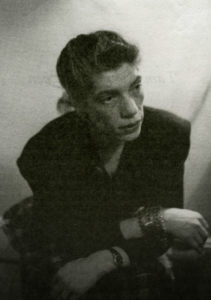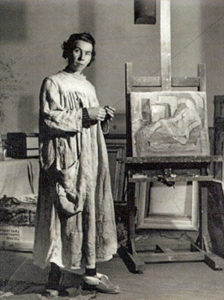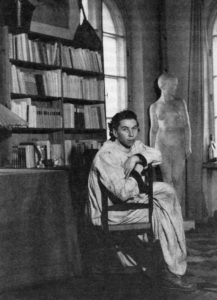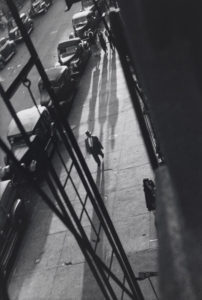Who was Eva Konikoff? Tove Jansson – Letters from Tove includes many letters from the artist and creator of the Moomin stories to Eva Konikoff, sent between 1941 and 1967. The editors of the letters, Boel Westin and Helen Svensson, refer to ‘Photographer Eva Konikoff’; Jansson sometimes calls her Konikova or Koni. I searched on-line for Eva under the various names with little success – links simply took me back to Letters from Tove. She does not appear on any of the extensive lists of women photographers collated by Wikipedia; and she is not recorded among the contributors to the ‘Family of Man’ exhibition (1955). Reading Jansson’s letters and the editors’ notes the merest outline of the mysterious Konikoff emerges. (It’s frustrating that we do not have Eva’s letters to Jansson.)
Eva was born in Helsinki in 1908; her background was Russian-Jewish and as a child she lived with relatives in Novgorod. Her parents divorced in 1916. Jansson writes about Eva’s ‘electric family atmosphere, your cheerless childhood and defiant, introverted youth’. She returned to Helsinki and worked at interior design company Hemflit-Kotiahkeruus (possibly concurrently with Marianne Strengell), where she met Jansson, who painted her in 1941.
Despite the distance apart during the period of their correspondence, Jansson sees Eva as her closest friend and confidante and the letters are treated as conversations, albeit rather one sided. She describes Eva as having, ‘wisdom of insight, life affirming strength, a permanently burning flame that even in moments of depression, and unconsciously, lends others its fire.’ Eva has a ‘big welcoming smile’; Jansson recalls her warmth, vitality and friendship; and calls her ‘shrewd and lively’.
Konikoff left for the United States in July 1941 as fighting started between Finland and Russia in the Continuation War (1941 – 1944). She stayed initially with her uncle Joseph Konick, in Philadelphia (he is later referred to as ‘your bad tempered uncle’). By the end of 1941 she has moved to New York and letters are addressed c/o H. Hansen, where she may have had the role of nanny – a letter of July 1942 to another address refers to Eva ‘no longer looking after Hansen’s brats’. In October 1944 Eva is staying with Mr. Saletan at ’70 Fifty Aveny, New York’.
The letters give some sense of how Eva is coping with life and work in the States. In October 1941 Jansson writes: ‘your descriptions give me a pretty clear picture of life over there, the glitter, the toughness, the bustle, the opportunities.’ She says Eva is right to take herself off to New York; and ‘Perhaps your relatives will be able to pull some strings’. Jansson wonders if she is happy and refers to the difficulty of coping with a new language. Concern about Eva’s job prospects, work pressures, and shortage of money recur through the letters. In 1941 Eva seems to be expressing a desire to get married and have children. Sometime in 1944-45 she married Ramon Cordova; by April 1948 they were divorced. In 1949 Jansson refers to Eva’s mental block about work and in 1952 to ‘the very lonely battle you are having with yourself’. In the late 1940s Eva is sending parcels of food, clothes, cosmetics and cigarettes to Jansson.
There are some hints at the nature of Eva’s professional life. In 1946 there is a reference to ‘your art magazines’ and in 1948 to a ‘promised magazine’. In May 1946 Jansson writes that as Eva is considering a trip to Paris she might meet ‘Monsieur Grosset, photographer, a delightful cultivated gentleman.’ This is almost certainly Raymond Grosset (1911-2000), who managed the Rapho photographic agency from 1946 to 1997. Grosset had trained as a film technician and was running a laboratory in Finland for Paramount by 1939. There are further references to a planned Paris visit is spring 1947, but it is not clear if it was ever made, and there is no evidence that Eva joined the agency.
A letter of April 1948 sheds some light on Eva’s involvement with the photographic community in America. Jansson writes: ‘So you’ve been building a house too! Well done them, for putting together their new Photo League themselves. You’ll have lots to tell me when we meet (just not about Berenice Abbott). I haven’t received the photos you referred to and am wondering whether you’ve sent them off or not. Will recent events [Eva’s divorce] have any detrimental effects on your photographic work? Have you got the equipment you need, or did Ramon take it all with him?’ On-line sources don’t record Eva as a member of the Photo League.
Eva had evidently written about photography to Jansson, who in April 1949 refers to ‘the wisdom [about photography] you’d passed on to me when you talked about your job’ and how this helped her when she was selected as one of the judges for a big photographic exhibition.
Eva returned to Finland for a visit in autumn 1949 and the editors write: ‘On that visit Eva Konikoff is also a guest at a meeting of the Amateur Photography Club in Helsinki (15.9.1949) speaking on the subject of “photography in America and showing her own picture collection” according to the minutes. The minutes also note that the “interesting pictures, which differed in some respects from Finnish perceptions of artistic photography, generated lively discussion”’. During the visit Eva took around 17 photographs of Jansson in her studio. In February 1950 Jansson writes she is ‘absolutely delighted’ with the pictures, saying, ‘They’re the most authentic pictures to have been taken here, both of me and of the studio….I even look quite attractive.’
None of the letters reveal what Eva is photographing in the States. But there is a tantalising hint in the editors’ introduction. Jansson writes to Westrin in 1998: ’I visualised a book about the Winter War and Eva’s brave new life in America as background, and it would have been illustrated with her terrific photographs of Harlem and Manhattan.’ And one more hint, equally tantalising: the web searches threw up a photograph: From Eva Konikoff’s Window, West 22nd St., New York, David Vestal, 1949.
Eva Kornikoff died in 1999. Who was Eva Konikoff?





Hi Brian, I’m making a short doc film about my cousin Eva Konikoff and the photo show that you talk about here. I would very much like to get a hold of you via email.
-much thanks
Mark Saran
msaran@olympus.net
EVA’S LOST SHOW
Thank you for getting in touch. I’m interested to know that you are making a film about EK. I don’t think I can add anything to what I’ve already posted, but will be happy to hear from you further.
Brian Human